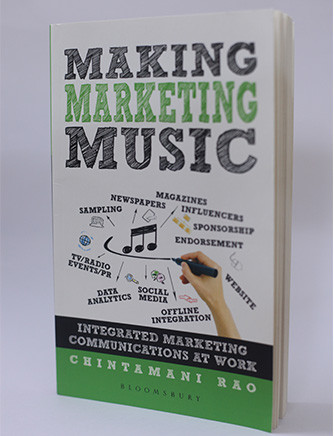Running an integrated marketing communications programme is like making music, says author and veteran adman Chintamani Rao in his recently released book ‘Making Marketing Music’. Now an independent consultant, Rao holds forth on how integrated communications works, when it doesn’t and how to make marketing music in the book, from which we present an excerpt
‘In the purpose-addled, fake-humble world of marketing these days the only brave people are the ones pointing out what a load of bollocks brand purpose actually is.’
—Mark Ritson
At the Cannes Lions Festival of Creativity in 2018, ‘There was little talk of some of the seismic challenges facing those in the marketing ecosystem…but plenty of discussion about needing to make a difference,’ wrote Russel Parsons in Marketing Week. ‘There are many clever people who have totally accepted that you have no hope of survival unless you can demonstrate that you are playing a positive role in people’s lives, their communities, and in the world at large.’
The idea that a brand must serve a purpose larger than that of business has been around for several years, but has only recently become the subject of so much discussion. At a time when the marketing function is in a flux, and much of the discourse on marketing forums is about justifying or defending the role of the chief marketing officer, this ‘purpose-is-everything’ thinking is a reflection of the zeitgeist, seeking a larger purpose for the marketing function by seeking one for the brands it serves. But where did it start?
The Stengel 50
In 2012 Jim Stengel, former Chief Marketing Officer of Procter & Gamble, posited the thesis that brands with a purpose or ideal, a ‘reason-for-being’ that goes beyond the mere business motive of making profits, grow faster than their peers. Stengel first identified the fifty brands with the highest scores for loyalty, or consumer bonding, in Millward Brown’s Brand Z database of 50,000. Looking for what these fifty had in common, he concluded that the X factor was a ‘Brand Ideal’, a shared intent by everyone in the business to improve people’s lives. He then looked at the growth in share prices over ten years of the companies that owned those brands, and found that the share price of the owners of the Stengel 50, as he called them, had grown 393%, while over the same period the S&P 500 declined by 7%. In other words, the owners of the Stengel 50 outperformed the S&P 500 by 400%. Clearly, ideals were driving business growth and success.
The thesis found broad support, which was not surprising. Even without going into the data and the thinking behind it, who would argue against doing good? Over the next several years the idea gathered momentum, and became the centrepiece of marketing discourse. Indeed, some would say 2018 was the year brand purpose went mainstream.
Research done in mid-2018 by Channel 437 in the UK made a case for brand purpose. Among its salient findings were the following:
1. 55% of respondents said brands should be a force for good in the world
2. 60% of young people (16 to 24-year-olds) notice ads more if they deal with important issues (55% of those aged 35–44 years; 37% of those over 45)
3. 57% of young people believe brands should use their advertising to raise awareness of social or ethical issues
4. 56% of 16 to 34-year-olds were willing to pay more for ethical products
In December 2018 Accenture released the findings of a global survey, reporting that 62% of customers want companies to take a stand on current and broadly relevant issues like sustainability, transparency or fair employment practices. It did say, though, that brand purpose is less important for companies producing basic, essential ‘utility’ products such as laundry detergent than for brands that offer an ‘experience’. Stengel’s thesis seems inarguable, and later independent research seems to corroborate the desirability of brand purpose from the consumer standpoint, even if not its impact on profits. But if you look into his methodology it appears to be a case of wishful thinking.
Wishful Thinking, Rationalised
Stengel first listed the fifty brands with the highest loyalty, or consumer bonding, scores. He then sought to determine if they were financially successful, and found that they were, which should have been no surprise. Seeking to find out what they had in common, he concluded that it was that they had high ideals. The ideals he identified for each were not the brands’ stated ideals: they were what he imputed. He didn’t start with brands that had declared ideals (the cause) and show that they were financially successful (the effect). He then classified the brands into five categories, saying that the ideals of the top-performing brands centred in one of five areas of fundamental human values:
1. Eliciting joy: Activating experiences of happiness, wonder, and limitless possibility
2. Enabling connection: Enhancing the ability of people to connect with one another and the world in meaningful ways
3. Inspiring exploration: Helping people explore new horizons and new experiences
4. Evoking pride: Giving people increased confidence, strength, security, and vitality
5. Impacting society: Affecting society broadly, including by challenging the status quo and redefining categories
 The identification of the brands with these five ‘fundamental human values’ is interesting. Google is in the ‘Inspiring Exploration’ group, never mind that Google’s own stated mission is simply, ‘To organise the world’s information and make it universally accessible and useful.’ For all its undoubted success—or because of it—Google is much maligned and, because of its ubiquity and seeming omniscience, often regarded with suspicion and called ‘the evil empire’. Yes, the same Google that Stengel says owes its success to its high ideals.
The identification of the brands with these five ‘fundamental human values’ is interesting. Google is in the ‘Inspiring Exploration’ group, never mind that Google’s own stated mission is simply, ‘To organise the world’s information and make it universally accessible and useful.’ For all its undoubted success—or because of it—Google is much maligned and, because of its ubiquity and seeming omniscience, often regarded with suspicion and called ‘the evil empire’. Yes, the same Google that Stengel says owes its success to its high ideals.
Speaking of big tech and ideals, consider the case of Facebook. After it being universally castigated; accused of everything from spying on you and selling your personal data to colluding with, or at least passively enabling, Russia to meddle in the US presidential election; and its CEO being grilled by legislatures in the US and Europe, it seems unlikely that people credit Facebook with anything in the way of high ideals. Nor is Facebook one of the Stengel 50, the world’s most highly consumer-bonded brands, yet as of the third quarter of 2018 it had 2.27 billion monthly active users. Let that sink in: 30% of the world’s population use Facebook at least once a month. What’s once a month, you say? Well, it had 1.5 billion daily active users, i.e., nearly 20% of the world’s population use Facebook every day.
And, no, that number was not declining in the face of all the controversy Facebook was mired in: daily active users grew from 457 million in the third quarter of 2011 to 1.5 billion in the same period of 2018—a compound annual growth rate of 18.45% over seven years, growing every single year. Whatever the questions about Facebook and its integrity, they were clearly not coming in the way of people across geographies, cultures, and age buying into the brand. And what of its financial performance? Facebook was listed on the NASDAQ on 18 May 2012. In the six years to 18 May 2018, its stock price grew by 378%, while the S&P 500 grew by 109%. Whatever drove its growth, it was clearly not public perception of its ideals.
Being a search engine, the more Google knows, the more useful it is. Ironically, though, the more it knows, and so the better it is, the more it is regarded with suspicion and apprehension. Yet users can’t seem to do without it: Google’s share of search engine usage is over 90% globally. Stengel also cites the case of Pizza Hut, though it is not on his list of 50. Pizza Hut lost its ideals in the 2000s in its chase for profit, he says. Eventually it rediscovered its lost ideals (with a little help from Stengel) and bounced back with double-digit growth as everyone concerned had a much clearer perception of what the company was trying to offer its customers. The ideal that Pizza Hut rediscovered was, ‘We believe the world would be a better place if we could invest more time in relationships that are important to us, and we exist to enable and support that’.
What’s wrong with Stengel’s contention? Simply that the ideal Pizza Hut is meant to have rediscovered is unmanageably broad and has a tenuous relationship, at best, with its core product and service offering, which is centred on pizza. If Pizza Hut exists to make the world a better place by investing in relationships, it might just as easily diversify into greeting cards or social media.
Stengel then uses stock prices of the brands’ owners to establish a causal relationship between ideals and financial success. But consider a brand like Dove (listed under the head of Impacting Society) and its possible impact on the stock price of Unilever. In 2011 the entire personal care category accounted for 33% of the company’s revenue of €46.5 billion, rising to 40% of €53.7 billion in 2017. Dove is, of course, a very big brand, but of the company’s portfolio of 400 it is only one of the thirteen that had sales of over €1 billion in 2017; and among the thirteen it is but one of five personal care brands. Given that, it seems exceedingly unlikely that Dove as a single brand could have a measurable impact on the stock price of Unilever.
There are, similarly, several other cases in the Stengel 50— Pampers for P&G; Sensodyne for Glaxo SmithKline and Johnnie Walker for Diageo, for instance—in which the identified brand has a relatively small share in the owner company’s sales, and presumably, therefore, a relatively small impact on its financial results and stock price. Further, having picked stock price as the indicator of success, Stengel uses the S&P 500 as the benchmark. But most of the brand owners are not listed on the NYSE or NASDAQ: many, if not most, are listed in Europe or Asia and several on other US exchanges. If ideals do drive success, and stock price does indeed demonstrate the relationship between ideals and success, consider Nokia. One of Stengel’s five fundamental human values is Enabling Connection, which includes six brands: Airtel, Blackberry, FedEx, Natura, Rakuten Ichiba and Starbucks. (Though FedEx thinks it is in the business of delivering business solutions, not of enabling connections.) If ever a brand was built on the thought of connecting people, it was Nokia. A perfect case, too, because the brand name was the company’s name. So how did that ideal play out for Nokia? In the period in question its stock price declined by 96%. What, then, of the research, most recently by Channel 4 and Accenture, which tells us that consumers believe brands should serve a larger social purpose, and prefer those that do? Such research is valid in so far as it asks respondents what they think and feel, and treats the finding only as what people say they think and feel. The problem is often with the way it is interpreted. The report says what it does. As with all market research, what you make of it and how you use it is up to you.
(Published with permission from Making Marketing Music: Integrated Marketing Communications at Work by Chintamani Rao, Bloomsbury India)























